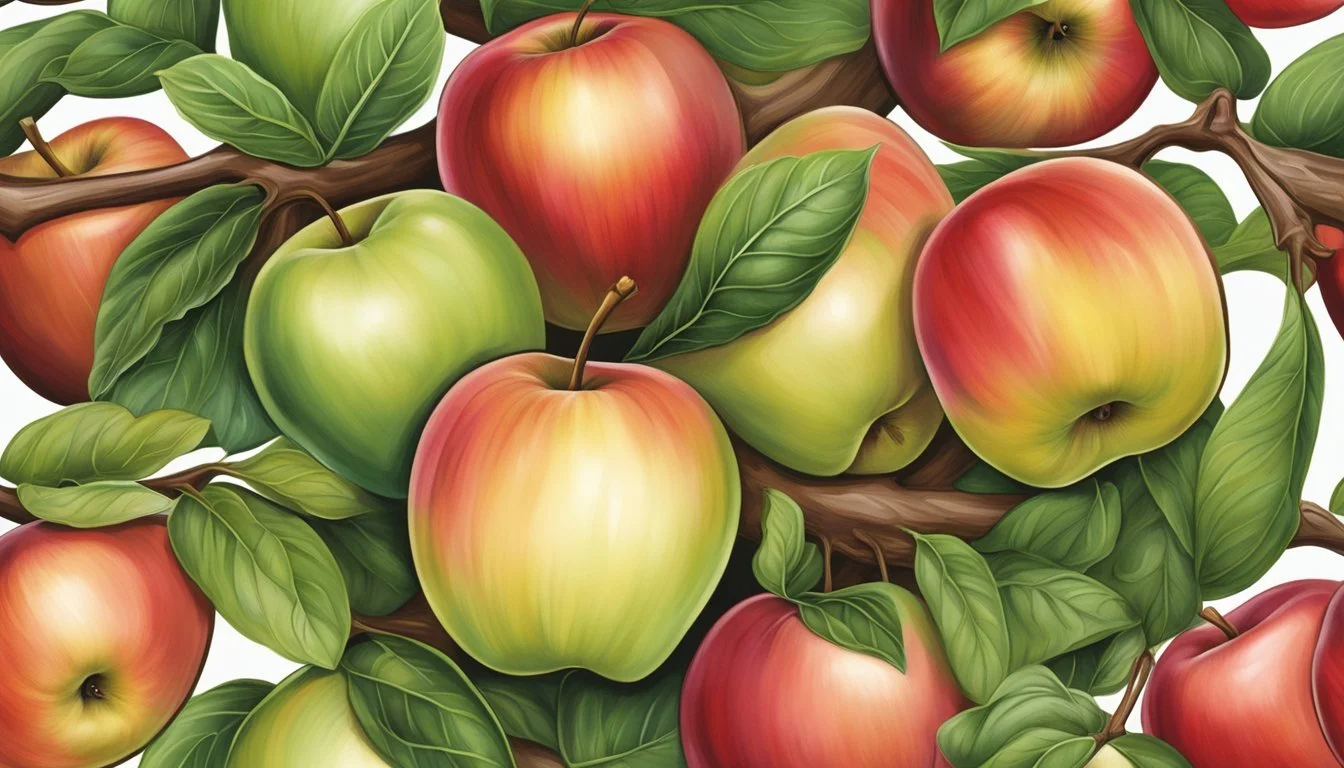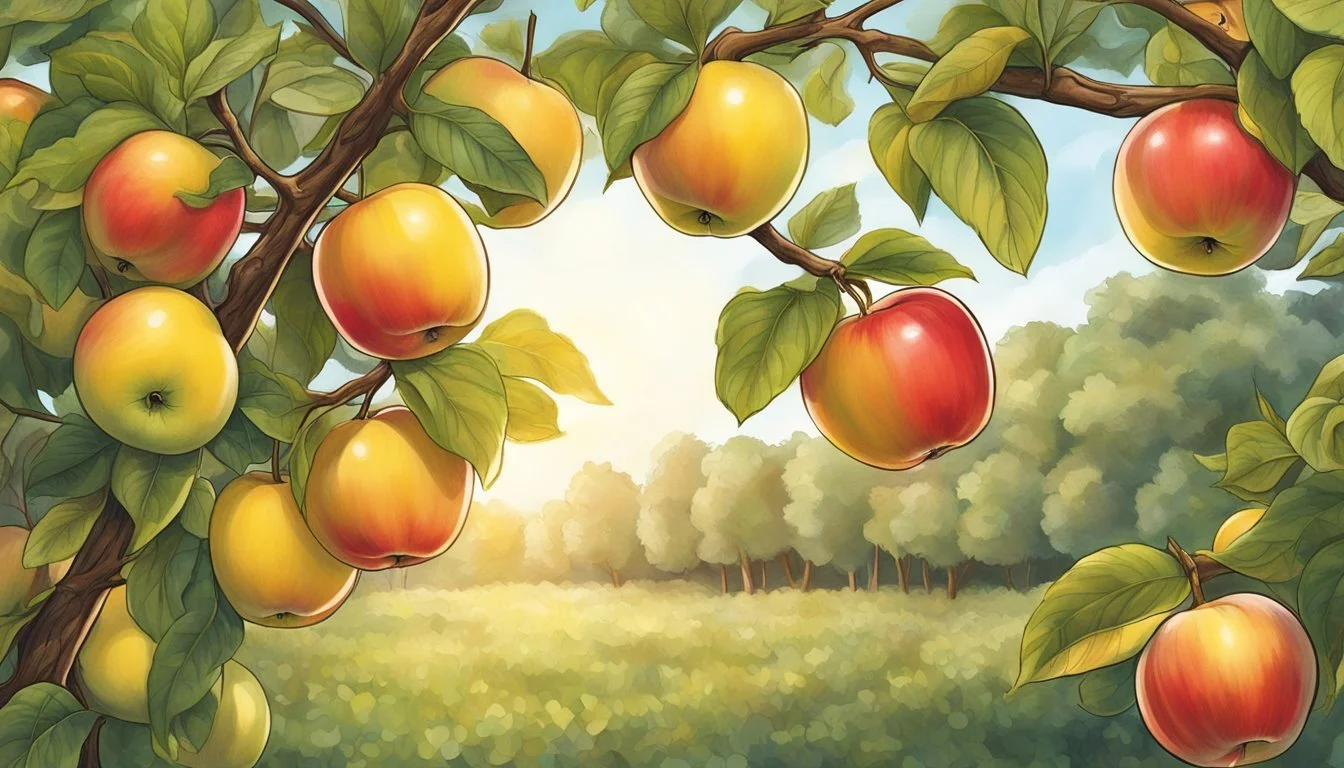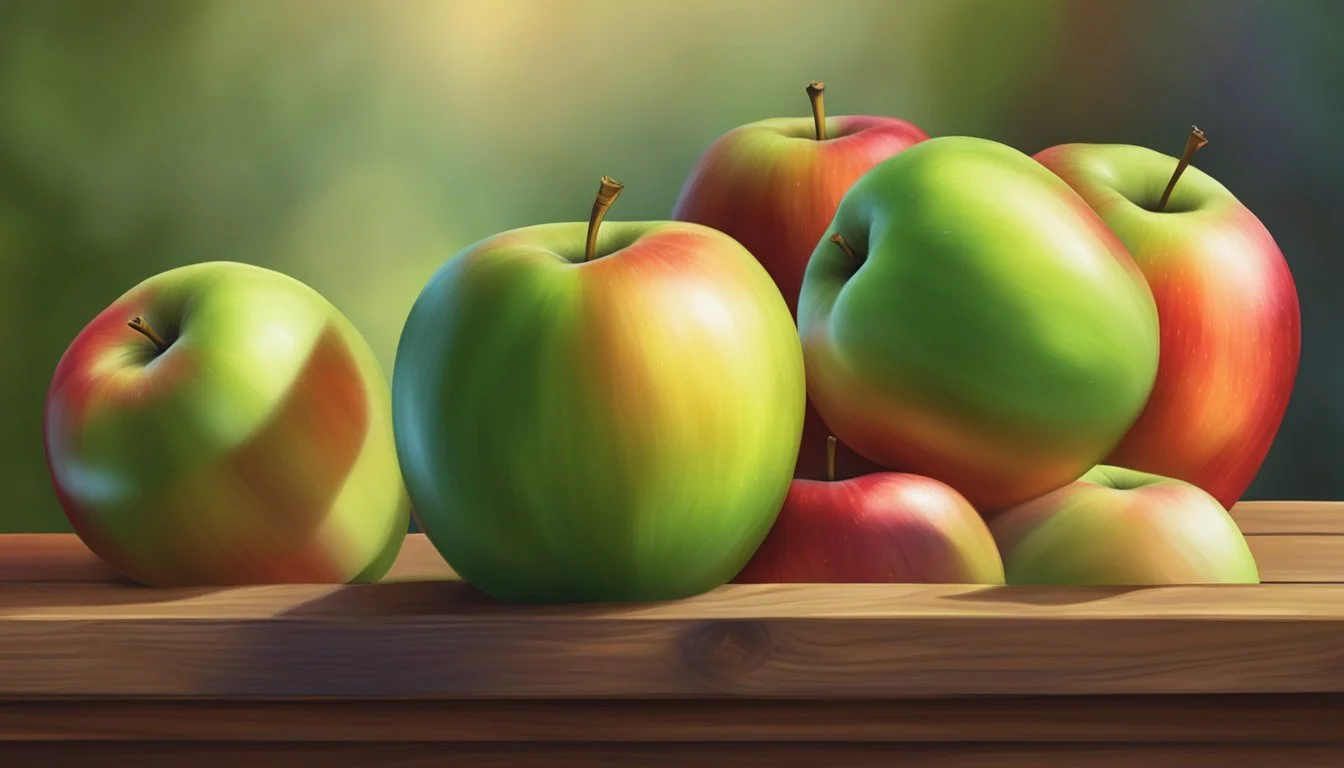How to Tell if a Braeburn Apple is Ripe
Selecting the Sweetest and Freshest Fruit
Determining the perfect time to harvest Braeburn apples is essential for any grower seeking to enjoy this fruit at its peak flavor. With their ideal blend of sweetness and acidity, Braeburn apples are a popular choice for both baking and fresh eating. The ripeness of these apples affects not only their taste but also their storage life and how they fare in the market.
To ensure that you are picking Braeburn apples at the right time, it is important to understand the subtle indicators of ripeness. Unlike some other fruit, color is not a reliable sign of maturity for Braeburn apples due to their natural variability in coloration. Instead, growers should look for changes in firmness and a sweet, aromatic scent. Additionally, the timing of the harvest can play a pivotal role in the flavor development of the fruit.
Key Takeaways
Braeburn apple ripeness cannot be judged solely by color.
A ripe Braeburn apple will have a balance of firmness and a fragrant aroma.
Harvest timing significantly influences flavor and storage quality.
Understanding Braeburn Apples
To fully appreciate the Braeburn apple, one must consider its origins, distinctive qualities, and how it measures up to other apple varieties. This section unpacks these aspects to give a complete picture of what makes Braeburn apples a favored choice.
Origin of Braeburn Apples
Braeburn apples trace their lineage back to New Zealand in the 1950s. An accidental cross between the 'Lady Hamilton' and another unknown variety led to the creation of the Braeburn. The apple was named after Braeburn Orchard where it was first commercially grown.
Characteristics and Unique Qualities
Braeburn apples stand out with their balanced sweet-tart flavor, a profile beloved by connoisseurs. The apples have:
A crisp and juicy texture
A taste with hints of spices, akin to cinnamon and nutmeg
An aromatic quality with subtle citrus-like notes
The visual appeal of Braeburn apples lies in their vibrant coloring, which includes:
A yellow or green base
Streaks of red or orange running vertically
These features contribute to the apple's unique sensory experience, making it both visually appealing and delicious.
Comparison With Other Apple Varieties
Braeburn apples often get compared to other varieties due to their well-balanced flavor profile. Compared to other sweet varieties, the Braeburn's tartness provides a refreshing counterpoint, while its sweetness is more pronounced when compared to generally tart apples. The apple's storability allows it to maintain its crispness and flavor for an extended period, differentiating it from varieties that may soften or lose taste over time in storage.
Growing Braeburn Apples
When cultivating Braeburn apple trees, it's crucial to consider the specific conditions that foster healthy growth and development. They require well-draining soil, sufficient sun exposure, and proper pruning techniques.
Optimal Growing Conditions
Braeburn apple trees prosper when planted in a location that receives 6 to 8 hours of full sun per day. They grow best in well-draining, fertile soil with a slight acidity, optimally with a pH range of 6.0 to 6.5. The ideal soil should be a mix of loam and sand to ensure proper drainage and avoid waterlogging, which can lead to root rot. It’s also essential that the trees are planted in a site that is shielded from high winds to prevent damage.
Pollination and Tree Maintenance
For successful pollination, Braeburn apple trees require a suitable pollinator variety close by as they are not self-fertilizing. The presence of another apple variety that flowers at the same time will serve as a pollination partner.
During the dormant winter months, they should only be pruned to shape and remove sick, damaged, or weak limbs to avoid undue stress on the tree. It's essential to select a vigorous rootstock to ensure robust growth and a better chance to withstand periods of drought.
Common Challenges and Diseases
Braeburn apple trees may face common challenges like any other apple variety. Pests, such as aphids and apple maggots, and diseases, including apple scab and powdery mildew, can afflict these trees. Routine maintenance to monitor for signs of pests and disease is critical. Implementing integrated pest management strategies and selecting disease-resistant rootstocks can mitigate these risks. It is always recommended to clear away fallen debris and diseased limbs to maintain tree health and prevent future outbreaks.
Identifying Ripeness
To ensure the perfect harvest of Braeburn apples, they must identify the fruit's ripeness through specific physical signs and employ proper harvesting techniques.
Physical Indicators of Ripeness
Color: As Braeburn apples approach ripeness, their color transitions from green to a deep red with possible streaks of green. They should look for a uniform coloration, indicative of a ripe fruit ready for consumption.
Texture and Firmness: The apple should feel firm when gently pressed. Neither excessively hard nor overly soft, the apple's ideal firm texture suggests a juicy and ripe interior.
Aroma: A ripe Braeburn apple emits a pleasant, sweet aroma. An increase in the fragrance from the apple's skin can signal its readiness for harvest.
Size: Braeburn apples should reach their expected size, typically medium to large, as a cue to their ripeness.
Harvesting Tips
Best Time to Pick: The ideal time for harvesting is when the apple separates easily from the tree with a simple upward twist of the stem. They should avoid pulling, as this action can damage future growth spurs.
Sunlight Exposure Check: Apples from the sunlit side of the tree tend to ripen first. They should prioritize these apples when checking for ripeness.
Stem Test: If the apple's stem snaps off easily without yanking, it indicates the fruit has achieved optimal ripeness for harvest.
Remembering these indicators will allow them to select Braeburn apples at peak ripeness, ensuring a delicious contribution to any apple recipe and maintaining the apple's naturally juicy and firm texture.
Utilizing Braeburn Apples
Once the Braeburn apples are ripe and picked, it's time to enjoy their crisp texture and tart-sweet flavor which make them versatile in the kitchen. They fit perfectly into various culinary applications and can be preserved for long-term enjoyment.
Culinary Uses
Braeburn apples excel in cooking and baking due to their balanced sweet and tangy flavor, which complements many recipes. They retain their shape and texture well, making them an ideal choice for pies and tarts. Here are some specific culinary applications:
Baking: Braeburn's firmness makes it perfect for baked goods like apple crisps, muffins, and bread.
Cooking: These apples can be used in savory dishes too, adding a unique flavor to pork roasts or sweet potato dishes.
Raw: Enjoyed raw, they are excellent for snacking or sliced in salads for a crunchy element.
Juicing: Their juiciness makes for flavorful apple cider or juice blends.
Tips for Perfect Usage:
For a firm bake, slice Braeburn apples thickly.
When used raw, a touch of lemon juice can prevent browning and enhance the apple's natural flavors.
Preservation Methods
Braeburn apples can be stored for future use while maintaining their fresh taste and crispness.
Freezing: Cut into slices or cubes, treat with a light ascorbic acid solution to prevent browning, and freeze in an airtight container.
Dehydrating: Can be dried for a chewy snack or to use in oatmeal and granola.
Applesauce: Cook down into a delicious applesauce, which can be canned or frozen.
Key Considerations for Preservation:
Ensure apples are thoroughly washed before any preserving method.
Label containers with the date to keep track of freshness.
With these practices, Braeburn apples can be incorporated into countless dishes and preserved to savor their quality year-round.
Storing and Enjoying Braeburn Apples
The key to maintaining the fresh taste and balanced flavor of Braeburn apples lies in proper storage. When stored correctly, the sweetness and the subtle hints of cinnamon and nutmeg inherent in their flavor profile are preserved. Enjoying Braeburn apples at their peak involves both the art of storage and the creativity of serving.
Proper Storage Techniques
For optimal freshness, Braeburn apples should be stored in the refrigerator. They are best kept in the crisper drawer, where humidity levels are higher, helping to maintain their crispness. It's ideal to store them away from strong-smelling foods to prevent flavor absorption. The temperature should be consistent, around 32°F (0°C), which prevents freezing and maximizes storage life.
Refrigerator Storage Tips:
Temperature: Keep at 32°F (0°C)
Location: Place in the crisper drawer
Separation: Store away from foods with strong odors
For those with an abundance of Braeburn apples, freezing is a viable longer-term option. Preparing apples for freezing involves peeling, coring, slicing, and ideally using a lemon juice or ascorbic acid solution to prevent browning. Once treated, the apple slices can be sealed in freezer-safe bags.
Freezing Guidelines:
Preparation: Peel, core, and slice the apples
Prevention: Dip in lemon juice or ascorbic acid
Packaging: Use airtight, freezer-safe bags
Pairing and Serving Suggestions
Braeburn apples are versatile in their use, making them an ideal fruit for a variety of pairings and recipes. Their balanced sweet-tart flavor complements both sweet and savory dishes. For a quick snack, Braeburn apple slices paired with sharp cheese or peanut butter highlight the apple's zesty notes. In cooking, they add a burst of flavor to salads, are robust enough for baking, and make a juicy filling for pies and pastries.
Fresh Serving Ideas:
Cheese Pairing: Sharp cheddar or gouda
Dip Pairing: Peanut or almond butter
When using Braeburn apples in recipes, their firm texture allows them to hold up well during cooking. For baked goods, dicing or slicing the apples and mixing them with spices like cinnamon and nutmeg can enhance the natural flavors of the fruit.
Culinary Uses:
Salads: Dice for a crunchy element
Baking: Slice for pies and pastries
By following these storage guidelines and serving suggestions, one can fully enjoy the delightful qualities of Braeburn apples any time of the year.
Braeburn Apples in Commerce
Braeburn apples play a significant role in the fruit market, favored for their unique flavor profile and storage longevity. They represent a thriving segment within apple commerce, involving intricate cultivation practices and extensive global distribution networks.
Commercial Cultivation
In commercial settings, Braeburn apples are recognized for their appealing crisp texture and a balance of sweet and tart flavors. Orchards in Washington state lead United States production, where farmers employ specific techniques to ensure apples meet market standards. Optimal sun exposure for at least 6 to 8 hours a day is vital, alongside rich, fertile, and well-draining soil for the cultivation of quality Braeburn apples. Precision in the pruning process is essential, with activity centered around the dormant winter months to shape the trees and remove any unhealthy limbs.
Sun Exposure: 6-8 hours
Soil Quality: Rich, fertile, well-draining
Pruning Season: Winter (dormant phase)
Global Distribution and Availability
The Braeburn's versatility in both storage and culinary uses has positioned it as a favorite in markets worldwide. Beyond the United States, these apples are cultivated in various European regions, benefiting from the warm apple-growing climates to achieve the ideal quality. Their ability to maintain freshness over extended periods allows for global distribution, making them available in commerce year-round. Farmers and distributors have honed practices to manage quality control, addressing any variance in taste and texture that may happen due to the different growing environments.
Key Markets: United States, Europe, and other warm regions
Availability: Year-round due to good storage qualities
Through attentive cultivation and a strong distribution network, Braeburn apples have secured a distinct and enduring presence in the commercial market.
Environmental and Genetic Considerations
When assessing the ripeness of Braeburn apples, one cannot overlook the crucial roles that both environmental factors and genetics play. Their interplay determines the fruit's quality, influencing its sweetness, texture, and the timing of ripeness.
Role of Genetics in Flavor and Texture
Genetics fundamentally shape the flavor and texture of Braeburn apples. Variations in genetic makeup are responsible for the degrees of sweetness and firmness observed in the fruit. A Braeburn apple with optimal genetics will often boast a crisp and firm texture, qualities that are sought after by both growers and consumers. Researchers have identified numerous genetic loci that correspond to these desirable traits, including the firmness of the fruit after harvest, an aspect that is significant when it comes to storage and transport.
Adaptation to Climate Change
Braeburn apples require specific environmental conditions to thrive, such as 6 to 8 hours of full sunlight daily and well-draining soil to develop their characteristic flavor. Adaptation to climate change is imperative, especially for orchards situated in warm climates where temperature shifts can affect the quality of the fruit produced. Apples grown in environments that deviate from these conditions may experience variations in ripeness timings and quality. Advances in horticultural practices enable growers to adapt to changing climates, ensuring that the apple's genetic potential is fully realized.




